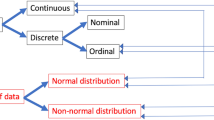Abstract
In this chapter we review common statistical methods used in medical studies and, in particular, in the field of rheumatology. We look at the choice of descriptive statistics, at statistical approaches for the comparison of treatments, and at methods to evaluate relationships between measurements. The reader is also introduced to Bayesian methods that have gained considerable popularity among statisticians and epidemiologists during the last decade. The focus will be on the intuitive ideas behind the methods rather than on their technical aspects. Practical guidelines are provided throughout the chapter as well as in a separate section. This will hopefully help in exercising good statistical practice (GSP). However, in view of the explosion of new statistical techniques, it is not realistic to give a comprehensive review. For the technical aspects of the statistical techniques, we refer the reader to other sources. The methods will be illustrated using rheumatoid arthritis data sets.
Access this chapter
Tax calculation will be finalised at checkout
Purchases are for personal use only
Similar content being viewed by others
References
R Development Core Team. R: a language and environment for statistical computing [computer software]. Vienna: R Foundation for Statistical Computing; 2010.
SAS® version 9.3 Cary, NC, USA, SAS Institute Inc. 2012.
IBM Corp. Released 2012. IBM SPSS statistics for windows, version 21.0. Armonk: IBM Corp.
Bland M. An introduction to medical statistics. 3rd ed. Oxford: Oxford University Press; 2002.
Petrie A, Sabin C. Medical statistics at a glance. 3rd ed. Chichester: Wiley; 2009.
Walter MJM, Mohd Din SH, Hazes JMW, Lesaffre E, Barendregt PJ, Luime JJ. Is tight controlled disease activity with online patient reported outcomes possible? J Rheumatol. 2014;41:640–7.
Van der Heijde D, Jacobs J. The original “DAS” and the “DAS28” are not interchangeable: comment on the articles by Prevoo et al. Arthritis Rheum. 1998;41:942–50.
Van der Heijde D, Van’t Hof M, Van Riel R, et al. Judging disease activity in clinical practice in rheumatoid arthritis: first step in the development of a disease activity score. Ann Rheum Dis. 1990;49:916–20.
Bruce B, Fries J. The health assessment questionnaire (HAQ). Clin Exp Rheumatol. 2005;23:S14–8.
Fransen J, Langenegger T, Michel B, Stucki G. Feasibility and validity of the RADAI, a self-administered rheumatoid arthritis disease activity index. Br Soc Rheumatol. 2000;39:321–7.
Wolfe F. Fatigue assessments in rheumatoid arthritis: comparative performance of visual analog scales and longer fatigue questionnaires in 7760 patients. J Rheumatol. 2004;31:1896–902.
Claessen SJ, Hazes JM, Huisman MA, van Zeben D, Luime JJ, Weel AE. Use of risk stratification to target therapies in patients with recent onset arthritis; design of a prospective randomized multicenter controlled trial. BMC Musculoskelet Disord. 2009;18(10):71.
de Jong PH, Hazes JM, Barendregt PJ, et al. Induction therapy with a combination of DMARDs is better than methotrexate monotherapy: first results of the tREACH trial. Ann Rheum Dis. 2013;72(1):72–8.
Visser H, le Cessie S, Vos K, Breedveld FC, Hazes JM. How to diagnose rheumatoid arthritis early: a prediction model for persistent (erosive) arthritis. Arthritis Rheum. 2002;46(2):357–65.
Aletaha D, Neogi T, Silman AJ, et al. Rheumatoid arthritis classification criteria: an American College of Rheumatology/European League Against Rheumatism collaborative initiative. Arthritis Rheum. 2010;62(9):2569–681.
Royall R. Statistical evidence. A likelihood paradigm. London: Chapman and Hall; 1997.
Svejgaard A, Ryder LP. HLA and disease associations: detecting the strongest association. Tissue Antigens. 1994;43:18–27.
Cox DR. Regression models and life-tables (with discussion). J R Stat Soc B. 1972;34:187–220.
Rizopoulos D. Joint models for longitudinal and time-to-event data: with applications in R. Boca Raton: Chapman and Hall/CRC; 2012.
Little RJA, Rubin DB. Statistical analysis with missing data. 2nd ed. New York: Wiley; 2002.
Lesaffre E. Longitudinal studies in rheumatology: some guidance for analysis. Bull NYU Hosp Jt Dis. 2012;70(2):65–72.
Panel on Handling Missing Data in Clinical Trials; National Research Council. The prevention and treatment of missing data in clinical trials. Washington, DC: The National Academic Press; 2010.
Verbeke G, Molenberghs G. Linear mixed models for longitudinal data. New York: Springer; 2000.
Molenberghs G, Verbeke G. Linear models for discrete longitudinal data. New York: Springer; 2005.
Lawton G, Bhakta BB, Chamberlain MA, Tennant A. The Behçet’s disease activity index. Rheumatology. 2004;43:73–8.
Molenberghs G, Kenward M. Missing data in clinical studies. West Sussex: Wiley; 2007.
Tunc R, Keyman E, Melikoglu M, Fresko I, Yazici H. Target organ associations in Turkish patients with Behçet’s disease: a cross sectional study by exploratory factor analysis. J Rheumatol. 2002;29(11):2393–6.
Gelfand AE, Smith AE. Sampling-based approaches to calculating marginal densities. J Am Stat Assoc. 1990;85:398–409.
Lunn DJ, Thomas A, Best N, Spiegelhalter D. WinBUGS – a Bayesian modelling framework: concepts, structure, and extensibility. Statistics Comput. 2000;10:325–37.
Lesaffre E, Lawson A. Bayesian biostatistics (statistics in practice). New York: Wiley; 2012.
Author information
Authors and Affiliations
Corresponding author
Editor information
Editors and Affiliations
Rights and permissions
Copyright information
© 2014 Springer International Publishing Switzerland
About this chapter
Cite this chapter
Lesaffre, E., Luime, J. (2014). A Review of Statistical Approaches for the Analysis of Data in Rheumatology. In: Yazici, H., Yazici, Y., Lesaffre, E. (eds) Understanding Evidence-Based Rheumatology. Springer, Cham. https://doi.org/10.1007/978-3-319-08374-2_2
Download citation
DOI: https://doi.org/10.1007/978-3-319-08374-2_2
Published:
Publisher Name: Springer, Cham
Print ISBN: 978-3-319-08373-5
Online ISBN: 978-3-319-08374-2
eBook Packages: MedicineMedicine (R0)




